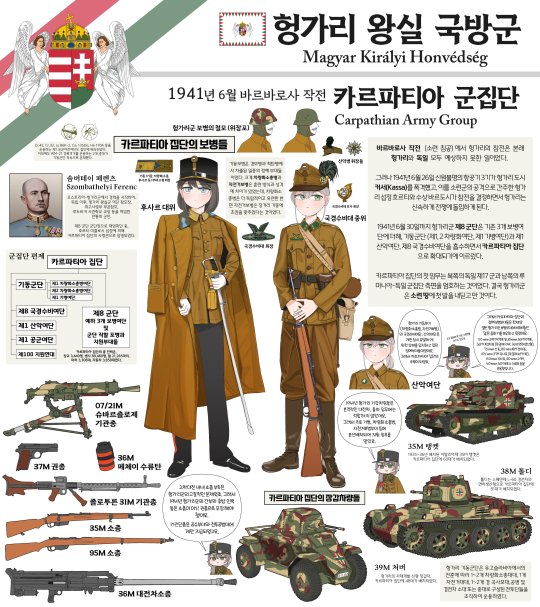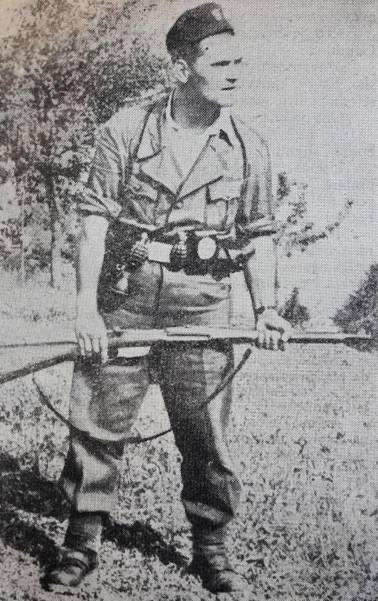#Mannlicher M1895
Explore tagged Tumblr posts
Text


1941 Carpathian Army Group, Hussar Major and Border Guard
#hejjyeo#Kingdom of Hungary#Regency Hungary#small arms#armor#L3/33#CV 33#35M Ansaldo#Toldi I#Landsverk L-60#39M Csaba#FÉG 37M#FÉG 35M#Mannlicher M1895#Solothurn S-18/100#Schwarzlose 07/21
15 notes
·
View notes
Text





Swiss 1893 Mannlicher Carbine 7.5 x 53.5mm
The 1893's bolt and receiver are almost identical to those of the Austrian M1895. However, unlike the M1895, the Swiss 1893 uses a detachable box magazine, fed by the standard Swiss stripper clips.
Other features of the 1893s included a full length stock and handguard, protected front sight, and a German-style sling-anchor in the buttstock. No provisions were made for a bayonet
The 1893 Carbine remained in production, from 1895 to 1905, when it was replaced by the Schmidt-Rubin Model 1905 Short Rifle.
13 notes
·
View notes
Text

Mannlicher M1895 Sniper Rifle from the Austro-Hungarian Empire dated between 1914 - 1918 on display at the Rainer Regimental Museum in Salzburg, Austria
The main difference from the standard rifle and sniper was the telescopic sight mount. The scope was mounted slightly to the left so the rifle could be fed by the en-bloc clip. Approximately 6,000 long and short barreled sniper rifles were made in the years 1915–1918 for the Austro-Hungarian Empire and used by sharpshooters on the Italian Front.
Photographs taken by myself 2022
#austro hungarian empire#first world war#austria#austrian#military history#20th century#hapsburgs#rainer regiment museum#salzburg#barbucomedie
27 notes
·
View notes
Note
Trick or treat! 🎃
You get the m1895 mannlicher!

2 notes
·
View notes
Text

People fought for independence of Crete a century ago, the large island in the Mediterranean known as a cradle of ancient Eurasian Civilizations, where was home to Minoans, Phoenicians and great tradition of Orthodox and Islam. Mannlicher M1895 is a service rifle in Greek Royal Army (Hellenic Army), Austro-Hungarian Army and Imperial Romanov Army.

Crete is a location to be featured in my RPG game "Teatime Empire: Romanov War of 1904" under development. From the Greek shore of Crete to the trench line of Port Arthur, there was a Cossack spymaster. Teatime is never passed up in the Empire.
#history#illustration#military#europe#fiction#greece#gamedev#rpg#indie dev#original character#austria
1 note
·
View note
Note
Anon, I have a 8x56mmR M1895 Mannlicher with 300 rounds for sale if you really want to stay in the straight pull market. LOL
Is a 5.56 straight pull a good option for defense? My only other options are 308 semi auto (limited to 10 round mags only) and a pump shotgun.
Under the circumstances I’d say shotgun
11 notes
·
View notes
Text







History revisionists get ready to be triggered. Today I added 20 round of 1938 7x56R ammo to my ever growing collection of vintage ammo. Last year I picked up a Steyr-Mannlicher M95 and thought this ammo would be a nice addition to a vintage rifle. The Nazi party and atrocity’s they inflicted should never be forgotten or romanticized. It was a horrific part of the worlds history, that doesn’t mean that history should be forgotten.
13 notes
·
View notes
Text

Steyr Mannlicher M95 - 8x56mmR
Source
#firearms#guns#rifles#straight pull action#straight pull#steyr mannlicher#steyr#mannlicher#m95#m1895#milsurp#vintage#8x56mmR
147 notes
·
View notes
Text
Steyr mannlicher m1895 carbine

The safety was located at the rear left side of the bolt. One specific feature of this system was that the clip has specific "top" and "bottom" sides, and could not be loaded into the rifle upside down. Non-empty clips could be removed from the top with the bolt open, by depressing the clip catch inside the triggerguard. Box magazine contained five rounds in en bloc clips as the magazine emptied, the clips were ejected from the opening at the bottom of the magazine. These ribs and cuts forced the bolt head to rotate on the pull of the bolt body, locking and unlocking the action. Bolt body had internal spiral-shaped ribs, with matching spiral-shaped cuts in the tail of the bolt head. Steyr Mannlicher M95 bolt has a separate head with two frontal locking lugs bolt head was inserted into the bolt body from the front. Earliest Mannlicher straight-pull rifles have had not so strong wedge-locking system, but in 1890 he introduced a straight pull bolt action with rotary bolt head with two lugs, which he latter used in M95 rifles. As a result, during the early part of the 20 century Mannlicher en bloc clip was generally replaced by the Mauser-type stripper clip. This significantly speed up the loading process, compared to the earlier designs with magazines loaded by single rounds the problem was that such magazine could not be loaded with loose rounds without the clip. Many of the M95 rifles were used during the Word War 2 by the Hungarian, Bulgarian and Italian armies, as well as by some German police forces.įerdinand Von Mannlicher developed his first straight-pull bolt action rifle by 1884, and by 1885 he developed the famous Mannlicher en block clip, which was inserted into the box magazine from the top, and automatically ejected through the opening at the bottom of the magazine as the last round was chambered. Hungary started to convert their rifles to the same 8x56R ammunition in 1931, with the upgraded rifles being marked with the letter "H" on the receiver ring. These rifles were designated as M95/30, and marked with the letter "S" on the receiver ring. Since 1930 Austria converted most of the M95 rifles to the more powerful 8x56R M30 ammunition, using the same Mannlicher en bloc clips. This conversion gave away with original Mannlicher en bloc clip, and replaced it with Mauser stripper clips. These converted rifles featured shorter 58 cm barrels, were designated as M95/24 and used in Yugoslavia and Bulgaria. Originally produced in 8x50R caliber, in 1924 some of M95 rifles were converted to the German 7.92x57 Mauser (also known as 8x57 Mauser) ammunition. This rifle was issued to Austro-Hungarian army, and, after the fall of the Empire, to the Austrian and Hungarian armies. More than 3 millions of M95 rifles were produced between 18. Based on his previous M1890 design, this rifle was manufactured in Austro-Hungarian Empire at state arms factories in Steyr (Austria) and Budapest (Hungary). The Steyr M1895 rifle, also known as Steyr-Mannlicher M95 straight pull rifle, was developed by famous Austrian arms designer Ferdinand Ritter Von Mannlicher. When Austria adopted the German 8mm Mauser cartridge in 1940, many were redesigned for this round. Based upon the straight pull bolt of the Steyr Mannlicher, designed by Ferdinand Ritter Von Mannlicher (known for the introduction of the first successful clip fed rifle).ĭuring WWII used by German police, reserve, and other non-frontline troops. The Steyr-Mannlicher m1895 Carbine, a cut down version of the original m1895 rifle when the rifle was rechambered from the 8x50Rmm cartridge to use the 8x56Rmm. Marked S on barrel in very good condition and strong bore. This gun is import marked, but all number match. Description: Steyr-Mannlicher m1895 Carbine in 8x56R.

0 notes
Text

Honvédség River Brigade
16 notes
·
View notes
Photo



AUSTRO-HUNGARIAN WW1 WEAPONS Shoutout To @lilis-palace & @chere-indolante For Making Such Great WW1 Uniform Download Link Here
Note: While in reality The Astro-Hungarian Empire Weapons during the Great War Are Hodgepodge of Armament With German Empire weapons that Covered in our Previous Post. This Post Was covering the Homegrown Weapons From Astro-Hungarian Empire that used During WW1 Despite one of them Are Never Actually Exist in Real life. Mannlicher M1895 The Mannlicher M1895 is an Austro-Hungarian bolt-action rifle, developed and designed by Ferdinand Ritter Von Mannlicher. It features a straight-pull bolt-action feeding from single-column magazine fed by en-bloc 5-round clips. The long rifle features a 30.1" barrel, and the carbine a 19" barrel. Both rifle and carbine feature a single-piece stock with full-length handguard. It fires the 8x50mmR cartridge. The rifle was produced at Österreichische Waffenfabriks-Gesellschaft, Steyr, from 1896 to 1918, and Fegyver és Gépgyár Rt. ("Arms and Machine Manufacturing Company") in Budapest from 1897 to 1918. Over 3,000,000 rifles were produced, roughly 75% at Steyr. Bulgaria purchased many M95s, beginning in 1903. It was the primary battle rifle of the Austro-Hungarian Landwehr and the Bulgarian Army during World War I, and continued to serve the postwar Austrian, Hungarian, and Bulgarian armies. Atleast until World War II Frommer Stop The Frommer Stop is a semi-automatic pistol produced in 1912 by Fegyver- és Gépgyártó Részvénytársaság ("Arms and Machine Manufacturing Company") Known As FÉG of Hungary. It was used throughout World War I and World War II by the Hungarian Armed Forces. Designer Rudolf Frommer adapted the design from another pistol that fired .32 ACP (7.65mm) from a seven-round detachable magazine. The weapon is unusual among automatic pistols in using a long-recoil system of operation. The Frommer Stop was available in 2 proprietary cartridges, similar to the .32 and .380 ACP, respectively. However, the Stop's cartridges had more powder and fired a heavier bullet. The Stop could fire regular .32 and .380 rounds, though, with less reliability. The Standschütze Hellriegel 1915 The Hellriegel 1915 is a prototype water-cooled submachine gun for or by the Austro-Hungarian reserves (Standschützen) during World War I, by a designer identified only as "Hellriegel". The weapon could be fed from either box magazines or chute-fed. A highly obscure weapon, no complete examples are known to still exist, no documentation remains, the only remaining evidence being three photographs dated October 1915 depicting the weapon being tested. As a result, its operating mechanisms and development history are pure speculation. Its apparent automatic fire capability and pistol caliber would make it one of the earliest sub machine gun designs in history.
@ts4-poses @ts4-poses-masterlist
#TS4#ts4cc#ts4 cc#thesims4#the sims 4#TS4WEAPON#ts4military#the sims 4 weapon#the sims 4 gun#the sims 4 military#ts4 historical#Decade Challenge#sims 4 decades#the sims 4 decades challenge#the sims 4 custom content#the sims 4 cc#history#ww1#ts4 WWI
105 notes
·
View notes
Text


World War 1 M1895 Steyr Mannlicher. Straight pull bolt action rifle chambered in 8x50R. Sadly, the ammo for this gun is no longer made, but it’s a beautiful piece of history.
50 notes
·
View notes
Photo



Mannlicher M1895 bolt action carbine, Austro-Hungarian Empire, World War I
from Hermann Historica
139 notes
·
View notes
Photo

Austro-Hungarian sniper with the Mannlicher M1895 takes aim on the fire step of a trench, 1916.
#ww1#wwi#great war#world war 1#eastern front#Austro-Hungarian Army#sniper#trench warfare#military history
181 notes
·
View notes

